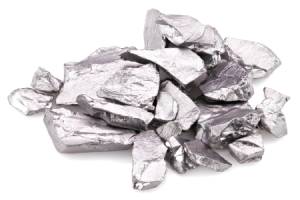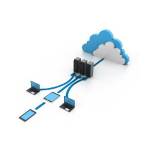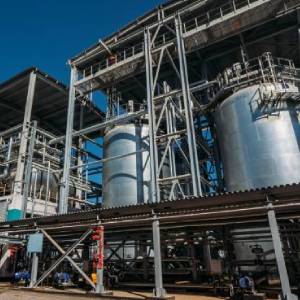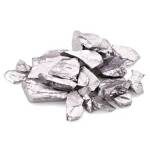Rare, resistant to corrosion, superconductive, and incredibly hard, tantalum may be the most intriguing—and the most important—metal you’ve never heard of.
Despite being rare and difficult to mine, tantalum plays an outsized role in modern technology. Most commonly, it’s used in electronic circuits and capacitors, which can be found in everyday items such as flat-screen televisions, mobile phones, computers, video game systems, and battery chargers. However, tantalum is a critical element in the expansion of electronics in our everyday lives. With the 5G rollout, which will fuel the demand for autonomous cars, IoT-connected devices, the backend infrastructure necessary to deliver work-from-home capabilities, and even smart cities, tantalum is projected to become increasingly important over time.
Its durability and high resistance to heat makes it a critical component of objects that can’t afford to fail, from vehicle airbags to spacecraft to nuclear reactors. Hypoallergenic, nonreactive, and durable, tantalum is emerging as a preferred metal for medical implants and surgical devices.
Sometimes called “blue gold,” tantalum has even picked up a following among the fashion-forward, having recently become a popular material for jewelry, especially tantalum wedding rings.
Over two kilotons of tantalum were used in 2021 – about half of global gold demand – and tantalum demand continues to grow. Tantalum demand has a projected CAGR of over 6% from 2022–2027 and represents an important investment opportunity. However, the metal is difficult to find and refine, the supply chain is complex, and current reserves are expected to run out around 2060, making it a particularly challenging metal to mine without the right level of technical expertise.
What is Tantalum?

Tantalum occurs in tantalite, columbite, and coltan, which is a mix of columbite and tantalite, and it is always found in conjunction with niobium, a chemically similar element. It was originally discovered in two different mineral samples by a Swedish chemist named Anders Ekeberg in 1802 but was thought to be the same element as niobium. However, in 1864, Jean Charles Galissard de Marignac, a Swiss chemist, discovered that niobium and tantalum could be separated by heating tantalum chloride in a hydrogen atmosphere and proved indisputably that they were different elements.
During the 19th century, scientists were able to produce only impure tantalum, but in 1903, German chemist Werner von Bolton was able to produce pure ductile tantalum, the first step on the metal’s path toward industrial usage. Tantalum has been named a critical mineral by the European Commission and the US Government.
Tantalum Characteristics
Rare
Tantalum makes up only about 2 parts-per-million (ppm) of the earth’s crust, making it one of the rarest metals on the planet. More commonly known rare metals such as neodymium, commonly found in electric vehicles as magnets3, are more abundant and cheaper than tantalum.
Hard
Tantalum is the third-hardest metal; only tungsten and uranium are harder. It exists in two crystalline phases: the alpha phase is ductile and soft; the beta phase is hard and brittle.
Resistant
Tantalum has extreme resistance to acids, corrosion, and bodily fluids. Its lack of reactivity makes it highly desirable for applications such as chemical equipment, heating elements, and surgical implants.
Refractory
Tantalum is part of the refractory metals group, a class of metals that are extraordinarily resistant to heat, wear, and corrosion.
Product Forms
Tantalum has four primary product forms, each with different applications:
- sheet (or plate)
- carbide
- powder
- alloys.
The sheet form, for example, is used in defense, chemical processing equipment, and for industrial purposes. The powder is used in capacitors and microchips, for creating high-temperature applications or corrosive-resistant coating on another metal, and in 3D printing. Research is underway to better understand tantalum’s application in hydrogen production and fuel cell applications.
Tantalum is also mixed with other metals to create highly durable alloys which are used in the production of jet engines and nuclear reactors. Tantalum is critical to energy efficiency gains as jet and turbine engines are being operated at hotter temperatures to improve fuel efficiency, requiring metals with greater heat resistance. Tantalum carbides, compounds composed of carbon and tantalum, are used to make cutting and boring tools and are sometimes added to tungsten carbide alloys.
Tantalum Uses
Tantalum’s earliest industrial use was for light bulb filaments. Since then, the metal has proved valuable in a number of industries and for a wide range of uses.
~5 million annual pounds
|
~35%
|
Capacitor Products Consumer Electronics |
 |
|
~18%
|
Oxides, Chemicals Optical Glass |
 |
|
~16%
|
Thin Films / Semiconductors Data Centers / Cloud Computing |
 |
|
~15%
|
Other Mill Products Chemicals Processing Equipment |
 |
|
~12%
|
Superalloys Jet Engine Components |
 |
|
~4%
|
Carbides Cutting Tools |
 |
Electronics
Over 50% of the tantalum produced is used in electronic capacitors and microchips, which can be found in automotive electronics, telecommunications infrastructure, and personal computers.
Alloys
Tantalum can be mixed with other metals to create highly durable alloys with a high melting point. Major end-uses for tantalum include superalloys for turbines used in the aerospace and oil and gas industries. Alloys are also used in missiles, tanks, nuclear reactors, and other high-heat, high-stress situations.
3D Printing
Tantalum can be printed using common printing technologies to create parts for the aerospace, automotive, medical, energy, and chemical processing industries.
Aerospace
Tantalum-based ceramics and carbides are used in spacecraft to shield components from radiation and heat, and missile parts.
Jewelry and Rings
Tantalum’s luster, rarity, and durability have made it a fashionable choice for jewelry, especially for men’s wedding bands. It is sometimes used in high-end watch mechanisms as well.
Glass Lenses
Tantalum oxide (Ta2O5) is used in glass lenses to make lighter-weight camera lenses that produce a brighter image.
Laboratory Equipment
Because it is chemically inert and resistant to corrosion, tantalum is often used in laboratory equipment and as a substitute for platinum.
Welding with Tantalum
Tantalum can be welded to any thickness, but welding must be done in inert gas chambers using helium or argon to avoid oxidation. It is not solderable, and it is difficult to grind. When annealed, it can be formed as metal sheets.
Tantalum Substitutes
Depending on the application, a variety of materials can be substituted for tantalum but often at greater expense or with a loss of performance and reliability. Possible substitutes include:
- niobium and tungsten in carbides
- aluminum, ceramics, and niobium in electronic capacitors
- glass, molybdenum, nickel, niobium, platinum, stainless steel, titanium, and zirconium in corrosion-resistant applications
- hafnium, iridium, molybdenum, niobium, rhenium, and tungsten in high-temperature alloy applications.
As an example, the original iPhone relied heavily on tantalum capacitors. Over time, however, these have been replaced by cheaper alternatives now that reliability and quality are no longer the priority. Tantalum is consistently used in new generation technologies or where reliability cannot be compromised.
Where is Tantalum Sourced?
Tantalum can be found across the world, however various factors contribute to where it is primarily mined. Australia’s historical tantalum production has come from just two mines, Wodgina and Greenbushes. Both mines ceased tantalum production in the late 2000’s, which provided an opportunity for small scale artisanal production from Rwanda, and the Democratic Republic of Congo to fill the supply gap. Throughout much of the 2010’s, 40% of the world’s tantalum came from the DRC, and 18% from Rwanda and Burundi.
Greenbushes and Wodgina are currently operating with a primary focus on lithium production, however the tantalum will be recovered as a bi-product. As demand for lithium grows over the coming years, there will be greater Australian production of tantalum and so Australia’s dominance in tantalum production is expected to return to historical levels, but with a very different cost structure.
Figure 1: Ta Ore Production by Region
A significant amount of tantalum production will continue to be sourced from the African Great Lakes Region from informal artisanal and small-scale mining operations. Today, several NGOs and other civil society groups, supported by organizations such as the World Bank, USAID, and the German Technical Cooperation, continue to try to find a sustainable solution by attempting to assist with the formalization and legitimatization of vulnerable artisanal miners who still rely on coltan mining for a livelihood.
These NGO groups are working directly with some of the world’s leading electronic and automotive manufacturers to ensure full and transparent (digital) traceability in the coltan supply chain. They provide upstream assurance and on-the-ground improvement programs, which seek to address key ESG risks in the DRC. Their efforts are slowly helping Congolese artisanal miners to connect to global supply chains while making their mines cleaner, safer, and more supportive for the artisanal miners themselves.
Brazil’s share of tantalum production has progressively fallen over many decades which is produced as a bi-product of mining niobium and tin and potentially lithium. There is also a healthy level of secondary sourced tantalum from recycling and processing waste streams. As an example, Thailand and Malaysia also produce tantalum as a bi-product of tin smelting, not mining.
Figure 2: World Mine Production and Reserves
| Mine Production | ||
|---|---|---|
| 2020 | 2021 | |
| United States | – | – |
| Australia | 34 | 62 |
| Bolivia | 7 | 7 |
| Brazil | 470 | 470 |
| Burundi | 24 | 32 |
| China | 74 | 76 |
| Congo (Kinshasa) | 780 | 700 |
| Ethopia | 69 | 52 |
| Mozambique | 43 | 43 |
| Nigeria | 260 | 260 |
| Russia | 49 | 39 |
| Rwanda | 254 | 270 |
| Uganda | 38 | 40 |
| World Total (rounded) | 2,100 | 2,100 |
Tantalum Mining
Tantalum mining and concentrating is a multi-stage process in part because the insitutional grades of tantalum are so low and associated with other minerals such as niobium, tin and lithium. Predominately found in open-pit mines, tantalum is sometimes mined underground as well. Tantalum ore grades vary but are generally somewhere between 100 and 400ppm Ta2O5.
The process begins with blasting to free the ore, which is then crushed and the tantalum concentrated by gravity separation. Typically, the ore is concentrated to around 5% Ta2O5 at or near the mine site. Some operations will take this primary concentrate and further concentrate to 28% Ta2O5, the globally recognized specification for tantalite concentrate for which you may see a quoted price that has varied between US$50 and $150/lb over the past two decades.
Tantalum Refining
Tantalum has many diverse uses and so the supply chain that feeds these final products is complex. Mining for tantalum includes the beneficiation of the ore to a primary concentrate (4-7% Ta2O5) or secondary concentrate (28% Ta2O5). Refiners further improve the purity and produce pure tantalum in metal or powder form.
The tantalum concentrate is then shipped to a refinery where the ore is treated using hydrometallurgy, in which the ore is leached with acids at high temperatures, allowing tantalum and niobium to dissolve as fluorides. Impurities are also dissolved as part of the process, and other metals (or metalloids) such as silicon, iron, manganese, titanium, zirconium, uranium, and thorium, are removed. After separating tantalum using filtering and additional processing by solvent extraction, the resulting product is an inert tantalum salt that can be shipped and further refined into various pure tantalum products through heat treatment.
Figure 3: Tantalum Supply Chain
Each individual market stream shown above can have multiple participants prior to the tantalum reaching the OEM customers. In the early 2000s the industry was plagued by volatility in its industry as each participant held large amounts of inventory. This impacted pricing and forecasts as poor inventory management created artificial shortages and oversupply dynamics. Today there are fewer participants and greater transparency in intermediary inventory levels, but with such a long timeline between Tantalum Mining and delivery of tantalum to OEM consumers, volatility still exists.
Unlike many other rare metals, the mining, smelting, and refining of tantalum are not controlled by China. More than 50% of the world’s processing and manufacturing capacity exists in the United States, with other major production facilities in US-allied countries such as Japan and Germany.
Investing in Tantalum
The growing demand for tantalum makes it attractive to investors, but investing in it isn’t always easy. Tantalum is not traded on commodities exchanges, and its price is determined in negotiations between buyers and sellers. Due to its small market size, few companies focus solely on producing tantalum, and many of these companies are privately held. As a result, gaining exposure to “tantalum stocks” can be difficult.
Tantalum Mining Companies
The following companies produce significant amounts of tantalum outside of conflict areas such as the DRC:
Leading Companies
- Global Advanced Metals Pty Ltd
- Pilbara Minerals (OTCMKTS: PILBF)
- Alliance Mineral Assets Limited
- AMG Advanced Metallurgical Group N.V. (OTCMKTS: AMVMF)
- Minsur
Public Companies
- Allkem (Formerly Orocobre) (ASX: ORE)
- Liontown Resources (ASX: LTR)
Junior Exploration Companies (companies with market capitalizations over $15 million)
- Arcadia Minerals (ASX: AM7)
- Commerce Resources (TSXV: CCE; OTC Pink: CMRZF)
- Critical Elements Lithium (TSXV: CRE; OTCQX: CRECF)
- Frontier Lithium (TSXV: FL; OTCQX: LITOF)
- Power Metals (TSX: PWM; OTC Pink: PWRMF).
Balancing Tantalum Investments with ESG Considerations
Post-COVID economic changes in business and personal practices have materially increased demand for tantalum, due primarily to growth in electronic components. Surging demand is spurring investor interest – but any successful effort to capitalize on the opportunities has to be informed by an understanding of the significant ESG risks, coupled with a commitment to responsible tantalum mining.
Along with tin, tungsten, and gold, tantalum is one of the four “conflict minerals” (sometimes called 3TG), which are characterized by operations that directly or indirectly finance or benefit state and non-state armed groups. Efforts are underway to ensure that only conflict-free sources of tantalum are used in the supply chain, benefiting local communities and investors alike.
The Democratic Republic of Congo, particularly the Kivu provinces, is considered the world’s largest producer of coltan, a mineral from which niobium and tantalum are extracted. From 1996 to 2003, the DRC, along with nine other African countries, was embroiled in ongoing transnational conflicts (termed the First and Second Congo Wars) with both national armies and over twenty-five different armed militia groups involved. An estimated $100M of coltan has been smuggled across the porous borders over the course of the wars. Some of those funds have gone to fund rebel factions responsible for widespread conflict, violence, and human rights abuses. This conflict is estimated to have led to at least six million deaths5. Although a peace agreement was signed in 2002, violence has continued since 2008 in many regions of the country, especially in the east.
Solutions to this situation are being vigorously pursued via a multi-stakeholder approach involving national governments, multilateral partnerships, and the business community. For example, this has led to the Responsible Minerals Assurance Process (RMAP), a tracing certification program created by the Responsible Minerals Initiative (RMI). RMI was founded in 2008 by members of the Responsible Business Alliance and the Global e-Sustainability Initiative to help companies responsibly source minerals in their supply chain. These efforts are aided by the fact that tantalum is also named in the Dodd-Frank Wall Street Reform & Consumer Protection Act in the US (DF1502), which requires companies listed on the US stock market to publicly disclose annually whether conflict minerals that are necessary to the functionality or production of a product originate from the Democratic Republic of Congo (DRC) or adjacent countries around the Great Lakes region of Africa. Tantalum is also subject to the European Union’s Conflict Minerals Regulation.
Thanks to these efforts, companies are increasingly aware of the ethical considerations around tantalum. They are taking steps, such as mapping supply chains and working with ethical smelters and refiners, to ensure they are using secure, integrated, and conflict-free sources of tantalum and to break their dependence on conflict regions.
Emerging Uses for Tantalum
Research and development of alternative uses of tantalum is extensive. Strong demand from electronics manufacturers, defense organizations, and medical research is driving expenditure to explore new applications for tantalum. Tantalum is desirable for additive manufacturing products due to its high heat tolerance, biocompatibility, high corrosion resistance, and resistance to harsh environments
- Angular powders are ideal for cold spray applications due to high coating adhesion and toughness. Applying tantalum and other refractory metals and alloys by cold spray enables rendering of high corrosion and temperature resistance to metal structures.
- Spherical powders are ideal for 3D printing and metal injection molding, due to their high packing density and good flow properties.
Tantalum Select Applications




Tantalum FAQs
What is tantalum used in?
Tantalum has a wide range of applications. While 50% of tantalum produced is used in electronic capacitors, it is also used in gas turbines, jet engines, and defence applications.
Is tantalum harmful to humans?
Tantalum itself is unlikely to be harmful to humans in most circumstances. In fact, due to its biocompatibility, it is often used in medical implants and surgical devices. However, tantalum dust has been known to irritate skin and eyes and can be moderately toxic when inhaled6.
Is tantalum a precious metal?
While tantalum is highly valued, it is not considered a precious metal. In fact, it is classified as a “minor metal,” that is, extracted as a by-product of base metals.
Is tantalum a rare earth element?
While rare, tantalum is not considered one of the 17 rare earth elements (REEs)7, metallic elements with similar physical properties that occur together in the periodic table.
Does China have a monopoly on tantalum?
While China does have refining capacity for tantalum, it does not have a monopoly, nor does it control the supply chain, as it does with rare earth minerals. Currently, Rwanda and the Democratic Republic of Congo are the leading suppliers of tantalum to Chinese refiners8.
Can you melt tantalum?
It’s not impossible to melt tantalum, but it is very difficult. At 5,462.6 °F (3017 °C), tantalum’s melting point is the fourth highest of all metals. The precise method for melting will depend on the form it’s in (powder, sheet, alloy, etc.) but generally calls for specialized equipment such as electron lasers.
Taking the Next Step
RCF believes that successful tantalum investment can only be achieved by taking this commodity’s ESG, legal, and ethical issues into account, and investing only in mining companies and smelters that:
- map their supply chains and follow Responsible Minerals Initiative Guidelines or an equivalent internationally recognized ESG certification framework.
- use providers that map their supply chains
- support industry programs for third-party tantalum smelters and those that meet stringent ESG requirements.
Every commodity in the mining industry has its own unique profile, prospects, and challenges. However, given tantalum’s unique role in future-focused industries, such as electronics, automotive, superalloys, and 5G technology, including cell towers and backend networks, the metal is likely to receive significant global attention as one of the few rare and strategic minerals controlled by US-allied countries. There is significant opportunity, but RCF recommends that investors interested in tantalum work with a partner that understands the nuances of each commodity opportunity, and the complexities inherent in the broader mining industry.
Like what you’re reading? Subscribe to our top stories.
Source of Data
1 NNIEC, Ningxia Nonferrous Metals Import & Export Corporation. http://www.nniec.com/tantalum.html
2 Royal Society of Chemistry, Periodic Table Tantalum. https://www.rsc.org/periodic-table/element/73/tantalum
3 American Chemical Society, Neodymium. https://www.acs.org/content/acs/en/greenchemistry/research-innovation/endangered-elements/neodymium.html
4 Mineral Commodity Summaries 2022. https://pubs.usgs.gov/periodicals/mcs2022/mcs2022.pdf
5 World Without Genocide, Democratic Republic of the Congo. http://worldwithoutgenocide.org/genocides-and-conflicts/congo
6 Material Safety Data Sheet Tantalum Products. https://www.vanderbilt.edu/vinse/facilities/safety_data_sheets/Tantalum_Ta.pdf
7 What are rare earth elements, and why are they important? https://www.americangeosciences.org/critical-issues/faq/what-are-rare-earth-elements-and-why-are-they-important
8 Global Tantalum Production, Conflict Minerals and The U. S. Dodd-Frank Act – What You Should Know. https://www.rembar.com/global-tantalum-production-the-u-s-dodd-frank-act-and-conflict-minerals-what-you-should-know/
Important Information
This information should not be deemed to be a recommendation of any specific commodity, company, or security.
This material is provided for educational purposes only and should not be construed as research. The information presented is not a complete analysis of the tantalum and/or commodities landscape. The opinions expressed may change as subsequent conditions vary. The information and opinions contained in this material are derived from proprietary and non-proprietary sources deemed by Resource Capital Funds and/or its affiliates (together, “RCF”) to be reliable. No representation is made that this information is accurate or complete. There is no guarantee that any forecasts made will come to pass. Reliance upon information in this material is at the sole discretion of the reader.
None of the information constitutes a recommendation by RCF, or an offer to sell, or a solicitation of any offer to buy or sell any securities, product or service. The information is not intended to provide investment advice. RCF does not guarantee the suitability or potential value of any particular investment. The information contained herein may not be relied upon by you in evaluating the merits of investing in any investment.
Investing involves risk, including possible loss of principal.
Contents
Tantalum Quick Facts1,2

| Melting Point | 5,462.6 ºF (3,017 ºC) |
|---|---|
| Boiling Point | 9,856.4 ºF (5,458 ºC) |
| Thermal Conductivity | 300 K, 57.5 W·m−1·K−1 |
| Thermal Expansion | 25°C, 6.3 µm·m−1·K−1 |
| Electrical Resistivity | 131 nΩ⋅m (at 20 °C) |
| Electron Configuration | Xe 4f14 5d3 6s2 |
| Word Origin | Derived from Tantalus, in Greek mythology Tantalus was a mythological Greek king and father of the mythical queen Niobe. |
| Color | Blue-gray |
| Other Names | Tantalium; sometimes nicknamed “blue gold" |

